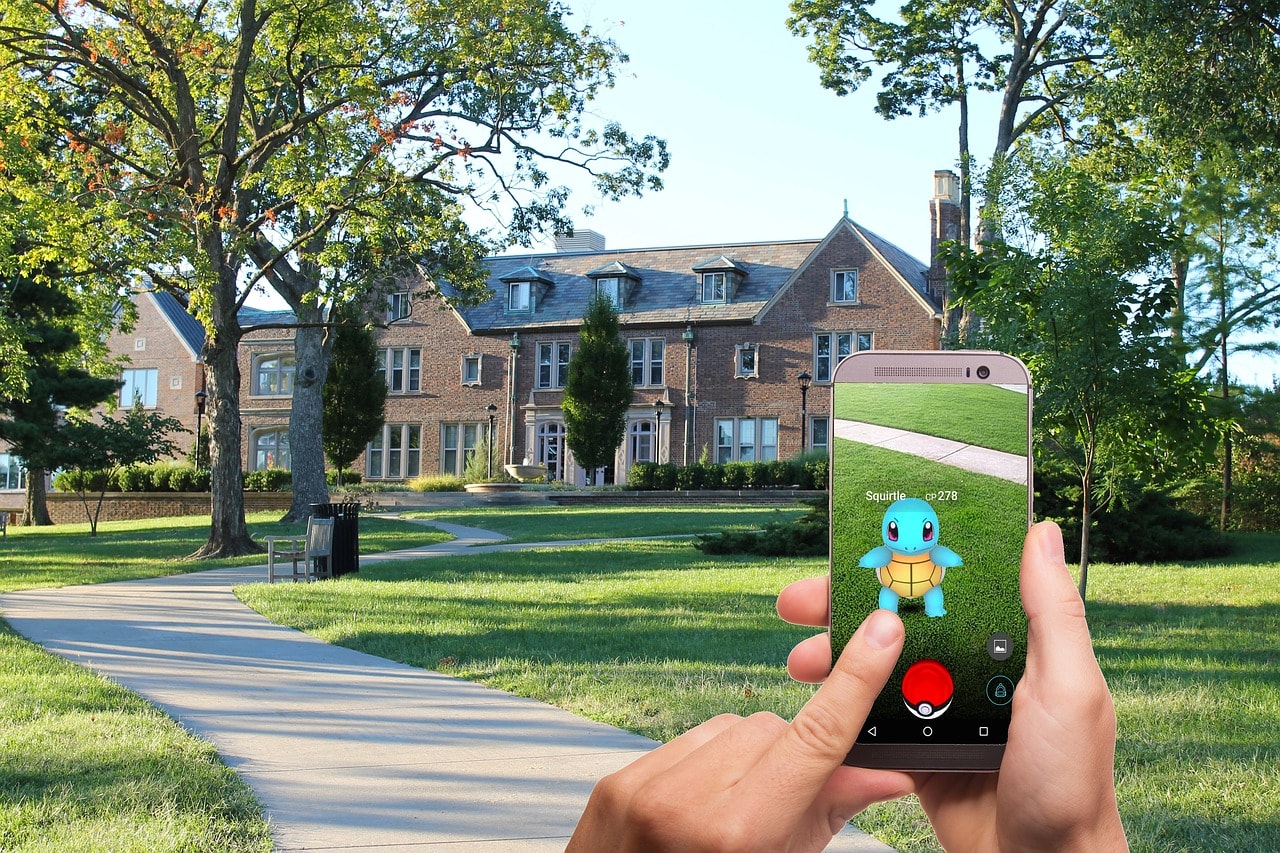This is How to Use Gamification to Make Boring Tasks Fun!
A couple of years ago I was running sprints on a Sunday morning on one of the intramural fields behind the gym at the University of Miami. All of a sudden, a car pulled up and a middle-aged woman got out and started running around with her eyes glued to her cell phone. At first, I thought she may be in the middle of some type of midlife crisis – then I realized that while that may be true, she was just playing Pokemon Go.

For those unfamiliar with the Pokemon Go craze, it was one of the first augmented reality success stories. Pokemon Go is a game where the real and digital worlds are blended together on smartphones causing people to run around capturing these little monsters that pop up alongside real-world physical objects on their phones.
Interestingly, one of the unintended consequences...
…of Pokemon Go was that those who played Pokemon Go started walking a lot more to capture those little monsters. While it was unintended, it does show the power of using games to complete boring tasks, which is a concept known as gamification.
Seeing how gamification got that woman running around reminded me of how I used gamification back in high school.
More on that later…
Do you have certain tasks in your life that you don’t look forward to doing because they are boring and mundane? I sure do. Most of the time we end up doing them anyway because they are a necessary part of life. But, it doesn’t have to be that way!
In today’s post, I am going to show you how you can gamify certain aspects of your life to make them more fun, more challenging, and less boring.
Before we go any further…
What is Gamification?
Gamification is simply motivating yourself to complete a boring or arduous task by turning it into a game or using elements from games. It works by enriching the reward for finishing a task with something more. And it enhances the reward of completing a task with something more concrete such as giving yourself some type of personal reward. For example, while having a clean house is the reward for cleaning your house, for some it isn’t enough to motivate us to do it. By turning it into a game or adding elements from games you are increasing extrinsic motivation by adding a more appealing type of reward.
Gamification is a strategy used by companies to accomplish a wide range of goals in areas such as marketing, employee engagement, training and education, recruiting and more.
What Does Gamification Look Like?
Many of you are probably familiar with some of the most common types of gamification or elements from games that are used in our everyday lives. They include leaderboards, badges, points, rewards, progress bars, contests, awards, trophies, and levels.
Some Interesting Gamification Examples Used By Different Companies Are:
Kaplan University…
used gamification to engage students more by making classes more fun and encouraging collaboration. They did this by using such gamification techniques such as leaderboards, quests, badges, and challenges which made the classes more fun and encouraged group collaboration. This led to an increase in the completion rate of courses as well as increased grades.
Cigna, Aetna, and Humana…
…have all used gamification to encourage employees to exercise. This has significantly reduced absenteeism, increased productivity, and improved employee engagement. For example, Humana has a program called Go365 which rewards participants who reach health goals with Go365 Bucks that can be traded for items such as gift cards.
LinkedIn…
…anyone who is on LinkedIn has seen the profile status bar which breaks setting up your profile into a series of steps. As you complete your profile the status bar gets longer which gives you a sense of accomplishment. This is a form of gamification that has resulted in a 20% increase in completed profiles.
Calm…
…. is a meditation app I use…
When I finish my daily meditation, I see this:

Then I see this:

By showing your progress, it uses extrinsic motivation to show you how much you have accomplished which makes you want to keep the streak going.
Deloitte…
…uses it for their Deloitte Leadership Academy (DLA), where they have seen a 37% increase in users returning to the site each week.
Before we get into some ideas that you can use to gamify your life, let’s look at some components you may want to integrate into your games. In his TED talk, ‘7 Ways Games Reward the Brain’, Tom Chatfield discusses…
Some Components of Games…
…that you can take from games to apply to situations other than games are:
Measure and indicate progress in small increments – so that people can watch and own their progress over time.
Multiple short and long-term aims – break things down into smaller pieces that people can choose and do at the same time to keep them engaged – like main quests and side quests.
Rewarding effort – giving people credit for trying while not punishing failure, you have completed something, great! It acts as a small enforcement.
Giving feedback – people can’t learn or get better unless there is feedback, it helps them learn a lesson and get better by linking consequences to actions.
Adding uncertainty – rewards excite people, but what really excites people is uncertainty or an uncertain reward. When we are unable to predict something, it really lights the brain up, makes us excited and we go back for more.
Other people – doing stuff with peers, collaborating with others increasing engagement, for example with multi-player games.
Chatfield’s point was that when all of these factors come together, and you get rewarded, your brain releases a chemical called dopamine which makes you feel good while motivating you.

The question is, can you utilize some of these factors to help you gamify your life and get more boring stuff done?
The answer is YES!
Let’s Look at 10 Examples of How You Can Gamify Your Life!
If you want to gamify tasks in your life that are boring or mundane all it takes is a little creativity! It is probably a good idea to also strategically add in some of the components from Chatfield’s TED talk that I referenced above.
I will get you started with 10 ways for you to gamify your life. I will give you 5 that leverage technology and 5 that don’t!
Let’s start with 5 that leverage technology:
(1) Forest
If you read my previous post on being present, you know that many of us can get distracted by our cell phones. One way to combat this is to use an app called ‘Forest’. Your goal is to not unlock your phone for 25 minutes, once you do, you get a tree, if you unlock it your tree dies. It’s kinda cheesy but it works.
(2) Starbuck’s
You accumulate stars and receive rewards after hitting certain levels, allowing people to see how close they are to their next free $8 coffee. It is a very well-done app that uses gamification.
(3) Duolingo
Is a platform you can use to learn a new language using gamification techniques such as using progress displays, levels and points. It also uses the element of access items and bottlenecks – meaning to unlock the next level in learning, you need to complete previous lessons which ensures you have the required skills. Interestingly on their webpage it says ‘Learning with Duolingo is fun and addictive.’ – meaning they are intentionally using dopamine as we discussed above.
(4) LoseIt!
One of the most popular weight loss apps out there which includes many elements of gamification such as badges, competition, rewards, and community.
(5) Waze
One that I personally use, Waze is a map app that not only helps get you where you want to go but also lets you know about real-time construction, traffic, accidents and more to get you to where you want to go faster. And it has a gamification component that rewards you for contributing to road information with badges, points etc. – those rewards help release dopamine which make you want to contribute while making your drive more fun.
Now a few that don’t involve technology:
(6) Chores
Get bored by doing chores? Need to motivate your kids to do their chores? Try creating a checklist with all of the to-do’s, check them off as you go and reward yourself at the end! Want to add a little uncertainty to the reward? Have a bunch of reward options available and then either roll some dice or pick a card from a deck of cards to see which reward you get!
(7) The line game
I don’t know about you, but I hate standing in line at the supermarket, bank, Home Depot – whatever. One game you can play is trying to guess which line will move the fastest and get in that line. Better yet, if you are in a self-checkout line, see how fast you can get through!
(8) Commute
See if you can beat your previous commute time by taking different routes! SAFELY of course!
(9) Doing homework
Involve your friends and agree to text each other at a certain time and agree on a set number of questions to finish and add some of reward/punishment for tasks completed/unfinished.
Let me take you back to when I was in high school for #10…
Even though I hated long distance running, I took a class that was comprised of running and lifting weights. We would run 3 miles x 3 times per week and lift weights the other two days.
After a few weeks, I realized I needed to do something to keep my sanity. I really hated the class for two reasons: the first was because I found running exceptionally boring and the second was because there was a kid in the class named Marty Wiggins. I don’t know what he ate, but he was always passing gas – and if you ended up running behind him…oh boy!
While I didn’t realize it then, I used gamification to solve my problem as I started to…
(10) Train with telephone poles!
I would make sure to get ahead of Marty ASAP. Then I would pick a telephone pole in the distance that was a bit far away. When he would get closer, I would run faster than normal until I got to it, then I would slow back down for a bit. Then when he would get closer I would pick another telephone pole and do the same thing.

Ironically, there actually is a name for this type of training, which is Swedish for ‘speed play.’
The word?
‘Fartlek’ training!!!
Not only did it help make my runs less boring, but it also helped keep me out in front of ‘Farty Marty!’
Until next time, keep gamifying your life and as always…PYMFP!
–Rick
P.S. Remember…we are all motivated differently, and gamification only works if it can motivate you to do something. So, the moral of this blog post is that you need to have a good understanding of what does and does not motivate you!
Use It or Lose It:
To use gamification to make boring or mundane tasks fun, see if you can be creative while utilizing some of the components from Chatfield’s TED talk.
When to Use It:
When you have boring or mundane tasks in your life that you want to make fun.
What Do You Think?
Do you use any of the ideas I have above to gamify your life to make boring and mundane tasks more fun? Do you have any other ways that you use gamification in your life? Please share in the comments below!
If you enjoyed this post, it would mean the world to us if you shared it with people you care about via any of the social media platforms below!
Popular Previous Posts:
12 Amazing Things I Learned from W. Edwards Deming
This is How to Boost Your Creativity Using Lateral Thinking!
12 Great Pieces of Life Advice from Old Steve Jobs Videos
How to Learn from Experiences With an After Action Review
Being Optimistic By Keeping Your Line in the Water!
References
1 https://lithosphere.lithium.com/t5/Science-of-Social-Blog/What-is-Gamification-Really/ba-p/30447
https://www.clicksoftware.com/blog/top-25-best-examples-of-gamification-in-business/
https://www.quora.com/What-are-good-examples-of-gamification-in-business
https://hbr.org/2013/01/how-deloitte-made-learning-a-g
www.mlevel.com/blog/top-10-gamification-examples-everyday-life/
http://blog.insynctraining.com/gamification-in-everyday-life
http://blog.insynctraining.com/38-achievement-unlocked-a-powered-up-understanding-of-gamification
https://blog.trello.com/get-more-done-gamify-your-life
https://community.lithium.com/t5/Science-of-Social-Blog/The-Magic-Potion-of-Game-Dynamics/ba-p/19260
https://www.ted.com/talks/jane_mcgonigal_the_game_that_can_give_you_10_extra_years_of_life
https://www.linkedin.com/pulse/real-life-gamification-good-bad-ugly-michael-wu-phd/
https://www.thbs.com/blog/infographic-how-gamification-can-help-enterprises
https://elearninginfographics.com/6-digital-signage-gamification-ideas-schools-infographic/
https://elearninginfographics.com/gamification-facts/
https://www.cutimes.com/2013/06/24/let-the-gamification-begin/?ref=rss&slreturn=20180726071639
https://elearninginfographics.com/gamification-educate-engage-entertain-infographic/
http://blog.surveyanalytics.com/2014/04/top-5-infographics-of-week-guides-to.html
https://create.piktochart.com/output/1965244-gamification

Rewards usually work with children too. To make household chores less boring I turn up the volume on my favourite music and turn on the fragrant scent diffuser. When I finish , I go for a nice walk if the weather is pleasant or I arrange to meet a friend for coffee or I read a book. Food and treats used to be my reward and it was a difficult habit to break.
Good morning Rick. We are recovering from last night, as we hosted our annual post-Halloween, pre-Christmas Wing-Ding party. A rousing success – no fights, sufficient designated drivers, nobody needed an Uber, and nobody slept on the floor here. OK, maybe I exaggerate just a bit.
I have never heard of this gamification process before, although after reading it, I have used some of the principles. So let me get into specifics.
Item 5 – we use google maps when driving. It shows the road clogs, then I find an alternative route in real time.
Item 7 – this is another example of what I term “Crowd Dynamics”. In the grocery store, the speed of the checkout line has nothing to do with the number of items being purchased, it depends on the number of transactions. The fewer the transactions, the faster the line. So there are times when the so-called ‘express line’ may actually be slower. Now let me give you a counter-example, which we experienced on Saturday. We had gone to the Dollar Store to buy some last minute items for the Wing Ding. Two checkout lines open, the shorter line had 4 people in front of us, the longer line consisted of maybe 5 or 6 customers. Here’s a great example of the exception to the rule of transactions. So we get in the shorter line, but the woman 2 people in front of us has a shopping cart piled to the top plus is also herding 3 kids, the oldest of which is maybe six. Of course the kids are pawing through all the crap on the Impulse Buying racks near the checkout stands, and “mom” keeps trying to herd them. I say to Joan “you stay here, I’m getting in the other line”. By the time I get up to the register in the other line, mom & brood are still taking items out of the cart, and Joan is two behind her. So she passes me her stuff and I pay for it. We are out the door before Mrs. Frustrated and Confused has finished unloading her cart.
Item 8 – When I drove to and from work, I always had alternative routes in mind. Sometimes it was preferable to drive the city streets part ways as opposed to the freeway. In fact, I could drive from work to the house (30+ miles) without never using a freeway, and did so several times.
Item 9 – In my senior year of high school, for some reason a group of us kids (about 5, me included) had the same set of classes. So we opted for the group homework method, each person attacking one subject, then passing around the results. We varied who did what. Maybe this week I figured out the physics assignments and Linda wrote up the history. Next week Steve attacked the physics, Linda figured out the math, and I delved into the history. The system worked, we all passed everything, plus had more time for just screwing around. Cooperate and graduate.
Hi Dave, sounds like you guys had quite the shindig! Glad to hear it went well and everyone had fun! Sounds like you use gamification in your life without even knowing it. Be good! Rick